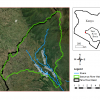Description
The Sasumua River Watershed in Kenya covers an area of 107 km2. The Sasumua River Watershed is a headwaters subwatershed of the Tana River Basin in Kenya. It is located within latitudes 0°39′0″ S and 0°46′48″ S and longitudes 36°34′48″ E and 36°40′48″ E. Elevations range between 2,200 m and 3,850 m above mean sea level. The average annual rainfall ranges from 1,000–1,600 mm. Land use in the watershed is primarily agricultural and forested. Waters from the Sasumua Dam provide 20% of the water supply for the City of Nairobi. The western and central parts of the watershed are characterized by poorly drained soils. Erosion and flooding in the western and central parts, and general land degradation in the watershed are key concerns impacting watershed water quality. (Mwangi et al., 2015).
This dataset comprises Climate Forecast System Reanalysis (CFSR, Saha et al., 2010) precipitation and temperature data and aggregated streamflow data as available and shareable for the Sasumua River Watershed.
The following data are included with the dataset:
- CFSR data (daily precipitation and temperature)
- Sasumua River Gaging Station (annual streamflow)
- Kimakia River Gaging Station (annual streamflow)
- Sasumua Other Water Data (aggregated reservoir information)
The data are packaged and deployed so as to be Findable, Accessible, Interoperable, and Reusable (FAIR) in accordance with open data FAIR Guiding Principles (Wilkinson et al, 2016).
Primary Data Columns:
- date: Calendar date (YYYY-MM-DD)
- prcpmm: Daily precipitation (mm)
- tmin_c: Daily Minimum Temperatures (degrees Celsius)
- tmax_c: Daily Maximum Temperatures (degrees Celsius)
- meanflow-cms: mean flow in m3/s
- minflow-cms: minimum flow, m3/s
- maxflow-cms: maximum flow, m3/s
Data Sources:
Original Reanalysis Data: Retrieved from National Centers for Environmental Prediction Climate Forecast System Reanalysis Versions 1 and 2 (https://doi.org/10.5065/D69K487J, https://doi.org/10.5065/D61C1TXF);
Raw Streamflow Data: Obtained from Kenya Water Resources Management Authority (https://wra.go.ke/).
Other Water Data: ETC East Africa Ltd, 2012. Upper Tana-Nairobi Water Fund Technical Report. The Nature Conservancy. (https://s3.amazonaws.com/tnc-craft/library/Upper-Tana-Nairobi-Water-Fund-Technical-Report_Feasibility-Phase.pdf?mtime=20180107044043)
Funding Acknowledgement
This dataset was made possible in part through support provided by the Center for Development Research, U.S. Global Development Lab (Lab), U.S. Agency for International Development, through the LASER PULSE Program under the terms of Cooperative Agreement No. 7200AA18CA00009. The opinions expressed herein are those of the author(s) and do not necessarily reflect the views of the U.S. Agency for International Development.
Cite this work
Researchers should cite this work as follows:
- Gitau, M. W.; Garibay, V. M.; Bancy Mati; Moriasi, D.; Kiggundu, N.; Munishi, S. E.; Alexander, A.; James Kisekka; Victor Kongo (2022). Precipitation and Temperature (1979-2020) and Annual Streamflow (1959-2001) Data for Sasumua River Watershed, Kenya.. Purdue University Research Repository. doi:10.4231/N75Q-ZW81
Tags
Notes
Version 1.0 of January 15, 2021
Raw data for this watershed cannot be shared due to restrictions on sharing placed by the data provider.
The user is responsible for evaluation and use of the data. The authors make no warranties and are not liable for any errors arising out of or in connection to access or use of the dataset and associated materials.
